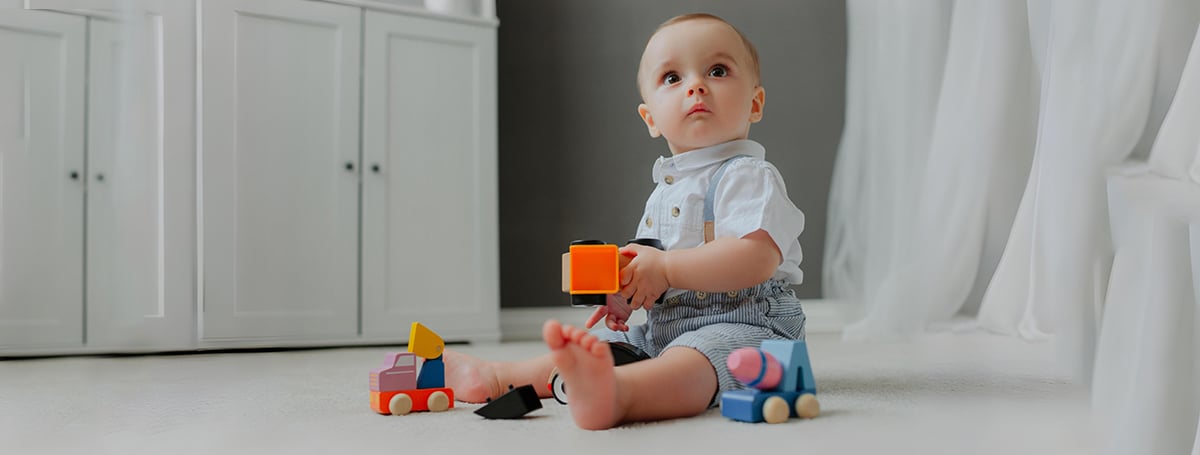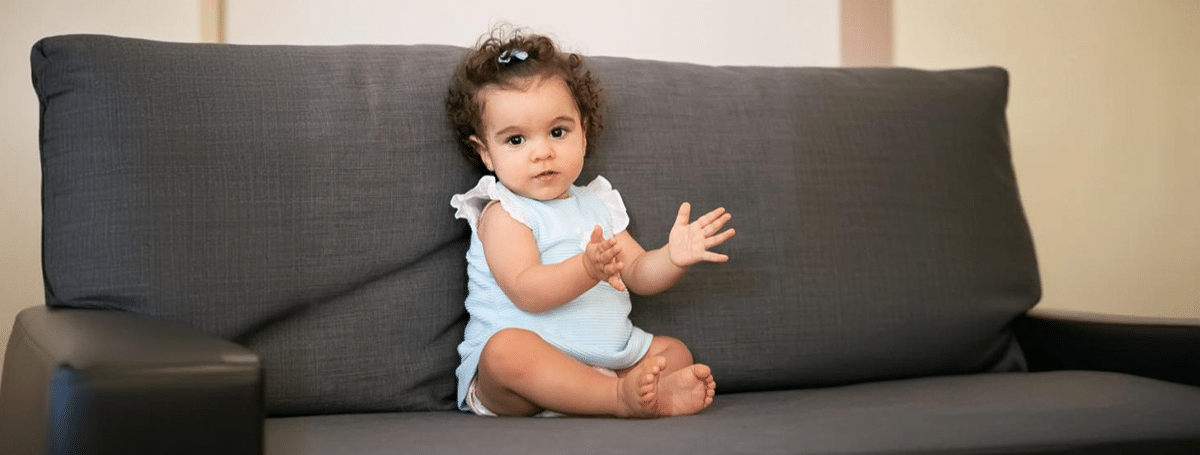7-Month-Old Baby’s Development Milestones: What to Expect and How to Support Growth
Have you noticed how your baby suddenly seems more curious about everything—from your face to the tiniest speck on the floor? At seven months, babies are little explorers, eager to interact with the world in new and exciting ways. This stage is full of delightful changes, new discoveries and tiny achievements that make parenthood even more special. Every baby grows at their own pace, and it’s natural to wonder what changes to expect at this stage. Whether it’s more interaction, new movements, or subtle shifts in behaviour, these milestones are signs of their incredible journey. Read on to discover the key 7 month baby milestones and what they mean for your little explorer.
Infant milestones and newborn milestones are important benchmarks for tracking development from birth through different ages. However, developmental milestones can vary from child to child and across different ages, so it’s important to observe your child to understand how they are progressing with respect to common milestone markers.
7 Month Old Milestones: Growth
At seven months, your baby’s growth may not be as rapid as in the first few months, but steady progress continues. Tracking your baby’s growth at this stage is important for monitoring developmental milestones and physical progress. On average, baby boys at seven months weigh around 8.30 kg and measure approximately 27.25 inches in length. Meanwhile, baby girls typically have a baby’s weight of 7.60 kg and an average length of 26.5 inches. However, growth can vary significantly from one baby to another, influenced by factors such as genetics, feeding patterns, and activity levels.
Most babies will follow their own unique growth patterns, and these can differ even among children of the same age.
This period of baby development at 7 months also marks a shift in energy expenditure. As babies start moving more—rolling, reaching, and possibly attempting to crawl—their calorie usage increases. This can sometimes lead to a slight variation in weight gain compared to earlier months. If you ever feel uncertain about your baby’s growth, their paediatrician can help assess whether they’re on track and provide guidance tailored to their unique needs.
Our Products
7 Month Old Milestones: Movements and Physical Development
At seven months, your baby is becoming more mobile, interactive, and curious about their surroundings. Their physical development is progressing rapidly, with stronger muscles and improved coordination. Here’s what to expect in terms of 7 month baby milestones:
- Rolling Over with Ease: By now, your baby has likely mastered rolling from tummy to back and back again. Some may even use rolling as a primary way to move around.
- Sitting Independently: One of the key 7 month old baby milestones is sitting without support. However, occasional tumbles are common, so it’s best to keep soft cushions nearby for safety. Some babies may even begin transitioning from their tummy to a sitting position.
- Getting Ready to Stand: With support under their arms, your baby can likely bear some weight on their legs and may enjoy bouncing up and down. This strengthens leg muscles in preparation for standing and walking.
- Exploring with Hands: Your baby’s hand-eye coordination is improving. They can now pick up objects with one hand, transfer them between hands, and bring them to their mouth for exploration. At this stage, they use a “raking grasp” to move small items toward them, though the pincer grasp (using the thumb and forefinger) will develop later.
- Crawling or Scooting: While not all babies crawl at seven months, some may start crawling, scooting, creeping, or using a mix of rolling and dragging to move. If your baby isn’t crawling yet, don’t worry—many babies don’t start crawling until nine months or later, and some may skip crawling altogether!
- Teething Begins: Your baby may start showing signs of teething, with tiny teeth emerging from the lower gums. Increased drooling, fussiness, and a desire to chew on objects are common symptoms. Bringing objects to the baby’s mouth is a way for them to explore new textures and sensations. Offering a chilled teething toy or washcloth can provide relief from oral discomfort.
At this stage, your baby is developing new skills and making ongoing progress in their physical abilities. Watch for these new skills as part of healthy development and celebrate each milestone as your baby grows.
7 Month Old Baby Milestones: Cognitive and Sensory Development
Baby development at 7 months includes significant improvements in memory, language understanding, and sensory perception. Your baby is becoming more aware of their surroundings and engaging more with the people and objects around them. Here are some key cognitive and sensory milestones to expect:
- Improved Memory: Your baby’s memory is getting sharper. They can now recall where objects were before they were hidden and may actively search for a toy that has been covered or dropped. This is why games like peekaboo or jack-in-the-box are particularly exciting for them.
- Recognising Familiar Faces: By now, your baby can clearly recognise parents, siblings, and other familiar people. They may smile or get excited when they see a loved one and may also show signs of stranger anxiety, preferring familiar faces over new ones.
- Better Understanding of Language: Though they can’t speak yet, your baby is becoming more attuned to language. They recognise their name and may respond when called. They are also beginning to understand simple words like “no” and can pick up on the tone of your voice, reacting accordingly to praise or disapproval.
- Full-Colour Vision and Enhanced Tracking: Your baby’s eyesight is now fully developed in terms of colour perception. They can distinguish a full range of colours and are better at tracking moving objects with their eyes, making interactive play more engaging.
7 Month Baby Milestones: Social and Emotional Development
At 7 months, your baby’s social and emotional skills become more evident. They are forming stronger bonds with caregivers, learning to express emotions, and becoming more interactive. Your baby’s personality is becoming more apparent at this age, with unique preferences and temperaments starting to show. A baby might display a range of behaviors, such as sudden bursts of laughter, clinginess, or curiosity about new faces and objects. Here are some key 7 month old milestones related to social and emotional growth:
- Separation Anxiety Begins: Your baby is now more attached to you and may become distressed when you leave their sight. This is why they may cry when you leave the room or wake up calling for you in the middle of the night. While this phase can be challenging, it’s a sign of their growing attachment and understanding of your presence.
- Recognising Emotions in Voices and Faces: By seven months, babies become more aware of emotions through facial expressions and different tones of voice. They may react with joy when you speak in a happy tone and get upset if they sense frustration or anger, showing sensitivity to different tones and emotional cues.
- Testing Boundaries: At this stage, babies start to test their independence. They might refuse to follow simple requests or resist certain actions. This is not misbehaviour but rather an important part of their emotional development as they learn about limits and reactions.
- Babbling and Early Communication: Your baby will be making more sounds, stringing together consonants like “da-da-da” or “ba-ba-ba.” While they may not understand the meaning of words yet, they use babbling to engage with you and attract your attention. Responding to your baby’s sounds and signals is important for nurturing their communication skills.
- Social Play and Interaction: Playtime is an essential part of your baby’s development. They enjoy playing interactive games like peek a boo, pat-a-cake, and nursery rhymes, which help them build social connections. Laughing, clapping, and mimicking gestures are ways they express happiness and engage with caregivers.
- Stranger Anxiety Develops: Around this age, your baby starts distinguishing between familiar faces and strangers. They may become shy or hesitant around new people, preferring the comfort of those they recognise.
Our Products
7 Month Old Baby Milestones: Nutrition and Feeding Patterns
At 7 months old, babies continue to rely on breast milk or formula as their primary source of nutrition. They typically consume 680 to 900 grams per day, spread over three to five nursing or bottle-feeding sessions. For formula-fed babies, each bottle generally contains 170 to 226 grams. Parents can introduce a sippy cup or straw cup with small amounts of breast milk, formula, or water (up to 113 grams) to help babies practice drinking independently. Avoid giving fruit juice to babies under one year old, as recommended by infant feeding guidelines.
In addition to this, solid foods become a regular part of a baby’s diet at this stage. Some babies are just starting to eat solids, with a few teaspoons of single-ingredient purees once a day, while others are ready for multiple meals. Both are normal, and the key is to follow your baby’s cues. One of the key 7 month baby milestones is the growing ability to gradually adapt to a variety of flavours and textures. Babies use their mouth to explore new foods and experience different tastes and textures, which helps with oral development and safety awareness. Parents can slowly introduce new foods every three to five days, monitoring for any allergic reactions. Common starter foods include mashed or pureed fruits (pears, applesauce, bananas, peaches), vegetables (squash, sweet potatoes, carrots, avocado), proteins (tofu, beans, chicken), dairy (soft pasteurised cheese, unsweetened yogurt, cottage cheese), small pieces of bread or crackers, and iron-fortified baby cereals.
7 Month Milestones: Sleep Patterns
By 7 months old, babies typically need 12 to 16 hours of sleep in a 24-hour period, including naps. While sleep schedules vary, many babies get around 10 hours at night and take two daytime naps, usually lasting a total of 4 hours. However, sleep needs differ from baby to baby, so a slight variation is completely normal.
Babies thrive on routine, and following a predictable sleep schedule can prevent overtiredness, which may actually make it harder for them to fall asleep. Sticking to a consistent bedtime routine, such as a warm bath, quiet playtime, or a soothing lullaby, helps signal that it’s time to sleep. To promote self-soothing, it is recommended to place your baby in their crib while they are drowsy but still awake. This helps them learn to fall asleep independently and prevents them from waking up disoriented when they don’t find you nearby.
Around this age, some babies experience a 7-month sleep regression due to separation anxiety or developmental leaps. Your little one might wake up at night to practice newly acquired skills like sitting up or babbling. If sleep regression occurs, continuing with good sleep habits and comforting your baby without creating new sleep dependencies can help ease the transition. Even babies with an established sleep routine may face sleep disturbances due to teething discomfort, separation anxiety, or changes in their environment. If your baby is frequently waking up and struggling to settle back to sleep, it may be worth consulting a paediatrician to rule out any underlying issues.
Ensuring your baby stays comfortable and dry through the night is also essential for uninterrupted sleep. Teddyy Baby Diapers with Susu Magnet Technology can keep your baby dry and rash-free through the night. Their extra-soft top layer provides added comfort, reducing discomfort that could wake your little one and promoting a peaceful and uninterrupted sleep routine.
Conclusion
Your baby’s journey at seven months is a beautiful mix of curiosity, discovery, and tiny but meaningful achievements. Each new skill—whether it’s a wobbly attempt at crawling, an excited babble, or a determined reach for a toy—is a glimpse into their growing personality. While these key 7 month baby milestones provide a helpful guide, don’t worry if your little one isn’t hitting all these milestones just yet—each child grows differently. However, if you have concerns about their development, it’s always a good idea to consult a doctor for reassurance and guidance. Celebrate their progress, be patient through the challenges, and most importantly, enjoy these fleeting moments of wonder. Your love, encouragement, and presence are the best gifts you can give as your little one continues to explore the world around them.
Tracking your child’s developmental milestones is an important part of the parenting journey, helping you support your baby’s growth and well-being.
Faq's
1. What milestones is my 7-month-old baby typically reaching?
At this age, most babies can sit unsupported, roll both ways, and show early signs of mobility such as rocking on all fours, belly scooting, or even pulling to stand. They’re also improving hand-eye coordination, transferring objects between hands, and may begin using the pincer grasp to pick up smaller items
2. What does a typical sleep schedule look like for a 7-month old?
By seven months, babies generally need 12 to 16 hours of sleep per 24 hours, which includes approximately 10–12 hours at night and 2–3 daytime naps. Some still take three naps (with the last being shorter), while others begin transitioning to two longer naps.
3. What kind of feeding schedule and solid foods are appropriate at this stage?
At seven months, breast milk or formula remains the main nutrition source, with babies typically taking 4–5 feeds per day, totaling around 28–34 ounces. Solid foods — including purees, iron-fortified cereals, pureed meats, fruits, vegetables, tofu, and legumes — are introduced progressively
4. Is my baby ready for finger foods or baby-led weaning at 7 months?
Many babies begin exploring soft, small finger foods between 7 to 10 months, especially once they can sit up unsupported and bring objects to their mouths. They don’t need teeth yet—gums can mash soft foods like steamed veggies or banana slices
5. How might teething impact my baby's behavior and daily routine?
Teething often begins around the 7-month mark, and might result in increased drooling, gum discomfort, irritability, or disrupted sleep. Teething relief strategies like offering frozen teething rings and chilled washcloths to chew on can help. Protective bibs can be used to manage drool.
6. When should I think about consulting a pediatrician if my baby's development seems delayed?
While development varies, consult a healthcare provider if your baby:
- Cannot sit with minimal support
- Does not babble or respond to their name
- Shows no interest in reaching or moving toward objects
Or displays persistent sleep or feeding difficulties that seem abnormal





